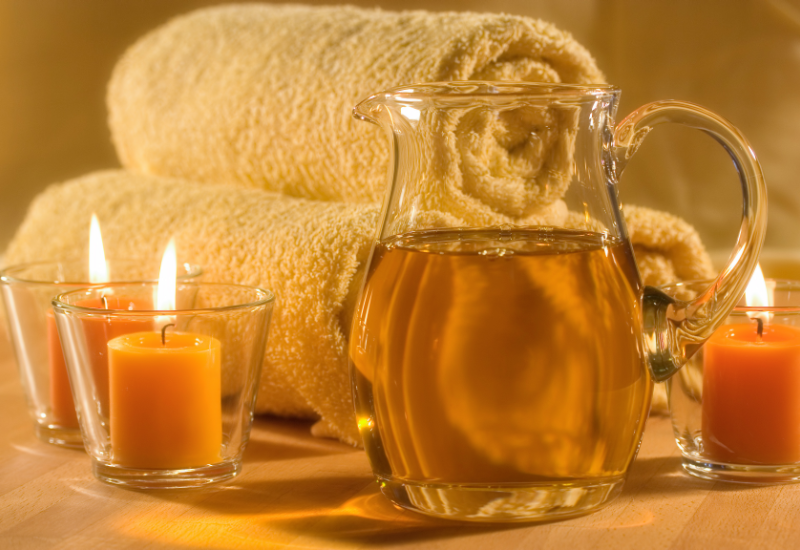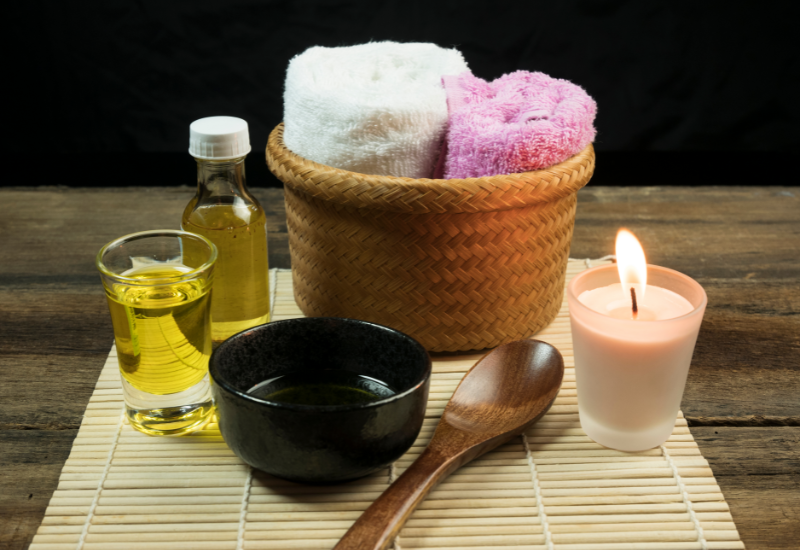
If you’re not already familiar with abhyanga, you may be thinking “‘Abhy—’ what?” You may have never years of it before! But stay with me here, because it really is a simple yet powerful practice to know about. I think you’re going to love this.
Move over oil pulling, because another Ayurvedic practice that’s been around for thousands of years is now starting to trend! It’s called Abhyanga— pronounced ab-hee-un-ga.
Deepak Chopra and I go into great detail on it in our book Radical Beauty, as it is considered a powerful anti-aging practice with great health benefits.
Now you may be wondering, “What is Abhyanga, and how do I do it?” Well, here’s a little overview to help make it super doable for your life. But first, let’s take a look at Abhyanga and the ways it can help you feel beautiful inside and out.
What is Abhyanga?
Abhyanga is the practice of giving yourself a nourishing and relaxing head-to-toe warm oil massage. Ayurveda believes that touching the outside of your skin can strongly and positively impact your nervous system, helping to dissipate the stress that we all know leads to inflammation and visible aging.
Ayurveda believes that Abhyanga is central in the rasayana, or anti-aging or rejuvenation practices, and that massaging your skin with warm, nourishing oils soothes your nervous system, which also helps to nourish your endocrine system and your immune system.
Daily abhyanga massage also helps restore dosha balance and is especially great for Vata dosha imbalances. In Ayurveda, doshas are the energies that make up your unique constitution, and keeping your dosha in balance helps you live the healthy life you deserve. The three doshas are Pitta dosha, Vata dosha, and Kapha dosha. [1]
- Vata Dosha: Air + Space/Ether
- Pitta: Fire
- Kapha: Earth + Water
These three doshas can be found in everyone and everything but in different proportions as a natural mix. When a particular dosha gets out of balance, we get out of balance. For instance, someone with a Vata-dominant constitution could have excessive Vata energy, which could contribute to dry skin and constipation.
The more we understand about balancing energies in our bodies, the more optimal our health will be! For more info on this, please be sure to listen to some of my podcasts with my Ayurvedic teacher, Dr. Jay.
Abhyanga is an expression of self-love and encourages grounding, well-being, and longevity. And it helps you look and feel great! Who wouldn’t love that?
The Benefits of Abhyanga
An Ayurvedic oil massage can do absolute wonders for your body and mind. In addition to balancing doshas, abhyanga has so many amazing physical benefits. Some of these include:
- Relieves fatigue
- Soothes your nervous system and calms your nerves
- Increases your circulation and blood flow
- Can positively impact your endocrine and immune systems
- Encourages lymphatic drainage, which helps with body detoxification
Massages are amazing sources of stress relief, and abhyanga is no exception! One study examined how abhyanga massage affected stress levels in 20 healthy adults. Before receiving a one-hour massage, the participants were required to fill out a stress-related questionnaire, and their heart rates were recorded. Following the massages, the study found that all participants had reported lower stress levels and decreased heart rates. [2]
Abhyanga is also great for giving you stamina, enhancing your sleep, nourishing your skin, and reducing signs of aging. But unlike visiting your facialist, abhyanga massage is free and you can do it at home.
It’s easy too, but you do have to do a little work. 🙂
What Do I Need for Abhyanga?
Now that I’ve convinced you to give abhyanga a try, here’s what you’ll need to do it yourself:
- An Ayurvedic herbalized oil, or organic, cold-pressed, unrefined sesame oil (This is best to use in the cold months as it is considered warming, and feels great in the colder weather, but it can also be used year-round)
- A closable, small glass or BPA-free vial or container
- 3-4 old towels (These are going to get super oily and maybe even stained!)
Some others you can try include almond oil, coconut oil, or jojoba oil. You can add your favorite essential oil to your massage oil for extra benefits too in small amounts. I recommend essential oils like mint, sage, lemon, or chamomile.

How Do I Perform Abhyanga Massage?
We’ve got our materials, now we can get started!
Note: It’s generally considered ideal to do your abhyanga practice in the morning to help release the toxins that have accumulated during the night and rejuvenate you for the day. But any time of the day is okay. I personally do it in the evenings because my mornings are chaotic with the kids and life and school rush.
1: Start by pouring about two tablespoons of your oil into a small jar. Place the jar into a bowl with hot water, and allow it to sit and warm naturally over 3-5 minutes.
2: To avoid slipping, sit on the floor or a chair near your shower. Apply some of the warmed oil to your hands and massage your entire body for 5 to 10 minutes, applying even pressure.
Apply lighter pressure to sensitive areas such as your upper torso, breasts, heart, and abdominal area. Use circular motions over rounded areas such as your feet and scalp and straight, longer strokes on your limbs.
3: Special belly time! Start on the right side and then make a circular motion up, across, and down the left side of your abdomen, repeating a few times. This is believed to help support digestion.
4: Next, massage the soles of your feet and the palms of your hands. Don’t forget about your face, ears, and neck.
If you have excessively oily skin and are worried about breakouts, you can always avoid your face.
5: Massage your scalp well. If you are like me and only wash your hair once or twice a week, you can wash your hands off first and massage your head with no oil.
Ayurveda teaches that the feet and scalp are the most important areas to stimulate with touch. Your scalp and feet are home to many important points of concentrated energy, known as marma points. So don’t skip this step! 🙂
6: When you’re done, make sure you’ve massaged the oil in as much as possible. Towel off the excess oil, especially on your feet, before attempting to walk or shower!
7: Ideally, you want to wait at least 10 minutes before you rinse the oil off.
You can brush your teeth, do oil pulling or whatever you want during that time. My Ayurvedic teacher said you can go work out, but I honestly can’t imagine doing yoga feeling so “sticky.” Eek!
But either way, take a hot shower next. The heat from your workout or the shower will help the oil penetrate transdermally, which is believed to help strengthen the connective tissues in your skin and help your skin stay supple. In the shower, only use soap on your private parts and underarms. Excessive use of soap can strip your skin of moisture and remove all those wonderful benefits you’ve just worked for!
8: Towel yourself off gently after you finish showering. Gentle is the keyword here: you want to pat your skin dry, rather than scrub.
After you towel off, you should still find a thin film of oil left on your skin. This is a good thing! It will help your skin stay moisturized and protected while keeping your muscles warm throughout the day. (Another bonus in the cold months.)
Our sense of touch is a wonderful thing. What helps us so much in the minutiae of our perfectly imperfect lives is also a powerful tool for healing, relaxation, and beauty.
A full-body massage not only feels great at the end of the day, but with the added benefits of ayurvedic therapy, you can turn this massage into a sensual, powerful health and beauty ritual.
Now it’s your time to try it for yourself and get your circulation going. Let me know how you did with your own Abhyanga practice.
Sending you much love today! ❤

Citations
- Ramaswamy, Sandhiya. “The Benefits of Ayurveda Self-Massage ‘Abhyanga.’” Chopra, Chopra, 23 Feb. 2021, chopra.com/articles/the-benefits-of-ayurveda-self-massage-abhyanga.
- Basler, Annetrin Jytte. “Pilot Study Investigating the Effects of Ayurvedic Abhyanga Massage on Subjective Stress Experience.” National Center for Biotechnology Information, Journal of Alternative and Complementary Medicine, 13 May 2011, pubmed.ncbi.nlm.nih.gov/21568717/.
The post Learn About the Incredible Rejuvenative Effects of Abhyanga appeared first on Solluna by Kimberly Snyder.
No comments:
Post a Comment